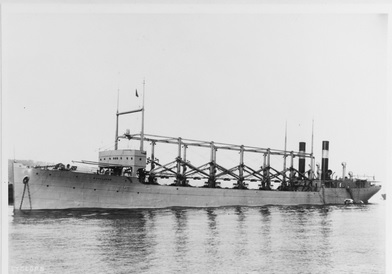 |
World War I, USS Cyclops
|
 |


It is feared that John Brawford who is in the navy is lost at sea. He was on board the Cyclops, a big American naval collier, which has been overdue at an Atlantic port since March 13.
Mr. and Mrs. J. S. Brawford, parents of the young man, received a telegram from Washington headquarters Sunday, stating that their son was on board the Cyclops and that it was feared the vessel was lost.
The navy department announced Sunday that the ship was last reported at a West Indies island March 4. The vessel was carrying a cargo of manganese from Brazil.
The Cyclops left the West Indies with one of her two engines damaged, but the department said this fact would not have prevented her from communicating by radio and all efforts to reach her by that means have been unsuccessful. A thorough search of the course which she would have followed in coming to port has been made and continues, it was announced.
There have been no reports of German submarines or raiders in the locality in which the collier was, the department’s statement said. The weather had not been stormy and could hardly have given the collier trouble.
There were 53 other naval enlisted mean on board besides John Brawford. John was the oldest of three sons who were in the army and navy. One of the boys was sent to the army camp at San Antonio where he contracted measles which affected his hearing and he was afterwards discharged from service on account of that defect.
John Brawford enlisted in May, 1917 and was sent to the naval training school at Brooklyn where he went into actual service in the navy a few months later.
Source: Vindicator and Republican, Estherville, Emmet County, Iowa; April 17, 1918.
Washington, D.C., April 30—As the final phase in the search for the missing naval collier, Cyclops the navy department announced today, numerous boat crews are being landed by warships to question fishermen along the coasts of the West Indian Islands near the route taken by the collier when she sailed from Barbados nearly two months ago.
Not one of the many vessels engaged in the search has reported the finding of wreckage or any other clue that would aid in solving the mystery. Navy officials admit that the time is drawing hear when they must formally give up for lost the big collier nearly 800 persons on board.
Source: Vindicator and Republican, Estherville, Emmet County, Iowa; May 1, 1918.
Please see Emmet County obituary page for obituary of John W. Brawford.

From the History Channel:
How could the biggest ship in the U.S. Navy vanish without trace? This
was the question on many people’s minds in March 1918, when an enormous
collier, the USS Cyclops, disappeared on a voyage between the West
Indies to Baltimore. A century on, it’s no closer to being answered.
The Cyclops was nearly 550 feet long, with a crew of 306 people and
around 11,000 tons of manganese aboard. She had been sailing
successfully since 1910, traveling between the Baltic Sea, the
Caribbean and Mexico and assisting with moving coal around the world
and helping refugees. But in 1917, when America entered World War I,
Cyclops became a key naval asset, transporting troops and coal to fuel
other ships all over the world.
In March 1918, the ship was given a new cargo: tons and tons of dense
manganese ore, used in steelmaking. She left Brazil loaded up with the
brittle metal, then voyaged to Barbados to resupply for the long
journey home to Baltimore. The last known message from the ship said
simply: “Weather Fair, All Well.” But on the nine-day journey,
something went awry, and no one from the ship was ever seen or heard
again—vanishing without even an SOS.
In a feature published a couple of years after the ship’s
disappearance, Santa Fe magazine described the strangeness of the
disappearance: “Usually a wooden bucket or a cork life preserver
identified as belonging to a lost ship is picked up after a wreck, but
not so with the Cyclops,” they reported. “She just disappeared as
though some gigantic monster of the sea had grabbed her, men and all,
and sent her into the depths of the ocean, and the suddenness of her
destruction is amplified by the absence of any wireless calls for help
being picked up by any ship along the route.”